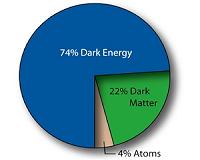 |
Valencia, Spain (SPX) Dec 03, 2010 Researchers from the Institute for Corpuscular Physics (IFIC) and other European groups have studied the effects of the presence of dark matter in the Sun. According to their calculations, low mass dark matter particles could be transferring energy from the core to the external parts of the Sun, which would affect the quantity of neutrinos that reach the Earth. "We assume that the dark matter particles interact weakly with the Sun's atoms, and what we have done is calculate at what level these interactions can occur, in order to better describe the structure and evolution of the Sun", Marco Taoso, researcher at the IFIC, a combined centre of the Spanish National Research Council and the University of Valencia, explains to SINC. The astrophysical observations suggest that our galaxy is situated in a halo of dark matter particles. According to the models, some of these particles, the WIMPs (Weakly Interacting Massive Particles) interact weakly with other normal ones, such as atoms, and could be building up on the inside of stars. The study, recently published in the journal Physical Review D, carries out an in-depth study of the case of the Sun in particular. "When the WIMPs pass through the Sun they can break up the atoms of our star and lose energy. This prevents them from escaping the gravitational force of the Sun which captures them, and they become trapped, orbiting inside it, with no way of escaping", the researcher points out.
The dark matter cools down the Sun's core "This effect produces a cooling down of the core, the region from where the neutrinos originate due to the nuclear reactions of the Sun", Taoso points out. "And this corresponds to a reduction in the flux of solar neutrinos, since these depend greatly on the temperature of the core". The neutrinos that reach the Earth can be measured by means of different techniques. These data can be used to detect the modifications of the solar temperature caused by the WIMPs. The transport of energy by these particles depends on the likelihood of them interacting with the atoms, and the "size" of these interactions is related to the reduction in the neutrino flux. "As a result, current data about solar neutrinos can be used to put limits on the extent of the interactions between dark matter and atoms, and using numerical codes we have proved that certain values correspond to a reduction in the flux of solar neutrinos and clash with the measurements", the scientist reveals. The team has applied their calculations to better understand the effects of low mass dark matter particles (between 4 and 10 gigaelectronvolts). At this level we find models that attempt to explain the results of experiments such as DAMA (beneath an Italian mountain) or CoGent (in a mine in the USA), which look for dark material using "scintillators" or WIMP detectors.
Debate about WIMP and solar composition "Our calculations, however, show that the modifications of the star's structure are too small to support this claim and that the WIMPs cannot explain the problem of the composition of the sun", Taoso concludes. Marco Taoso, Fabio Iocco, Georges Meynet, Gianfranco Bertone y Patrick Eggenberger. "Effect of low mass dark matter particles on the Sun". Physical Review D 82 (8), octubre de 2010. DOI: 10.1103/PhysRevD.82.083509.
Share This Article With Planet Earth
Related Links Spanish Foundation for Science and Technology Stellar Chemistry, The Universe And All Within It
 UBC Physicists Make Atoms And Dark Matter Add Up
UBC Physicists Make Atoms And Dark Matter Add UpVancouver, Canada (SPX) Nov 30, 2010 UBC and TRIUMF physicists have proposed a unified explanation for dark matter and the so-called baryon asymmetry--the apparent imbalance of matter with positive baryon charge and antimatter with negative baryon charge in the Universe. The visible Universe appears to be made of atoms, and each of these atoms carries a positive baryon charge equal to total number of protons and neutrons in i ... read more |
|
| The content herein, unless otherwise known to be public domain, are Copyright 1995-2010 - SpaceDaily. AFP and UPI Wire Stories are copyright Agence France-Presse and United Press International. ESA Portal Reports are copyright European Space Agency. All NASA sourced material is public domain. Additional copyrights may apply in whole or part to other bona fide parties. Advertising does not imply endorsement,agreement or approval of any opinions, statements or information provided by SpaceDaily on any Web page published or hosted by SpaceDaily. Privacy Statement |